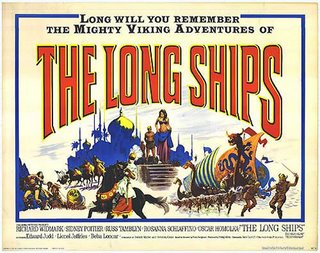
For a nine-year-old, it was a big deal.
A Saturday matinee at the now-long-defunct Baronet Theatre in Long Branch, N.J. The movie: “The Long Ships,” a 1964 Viking adventure already in its third or fourth re-release. Lots of action and spectacle, a simple plot, larger-than-life acting (Richard Widmark as a Viking conman, Sidney Poitier as a Moorish warrior prince). In short, perfect Saturday matinee material.
Two things left a major impression on my nine-year-old mind. The first was a scene in which captive Vikings are threatened with “The Mare of Steel,” a Moorish torture/execution device that resembled a razor-sharp playground slide. The second was a stirring musical score, featuring a main theme that would haunt me for years afterward. Never mind the fact that, during the film, it most often accompanied shots of miniature Viking ships being tossed around in a studio water tank.
I saw the film on TV occasionally in the years that followed, would seek it out just to hear that music again. The older I got though, the more I realized the movie itself was ... ehh, not so good. The dialogue and characterization were anachronistic, the humor forced, and Poitier’s wig seemed to have a life of its own. But that music ...
In my late teenage years, I began the search in earnest. I discovered that an LP of the music — by Yugoslavian composer Dusan Radic — had indeed been released on Columbia’s Colpix label in 1964, but had gone out of print shortly afterward. In those pre-internet years, it became one of the rarest — and most expensive — soundtrack albums. I hunted for it in used record stores everywhere I went, and found it only twice — once for $75 in Red Bank, N.J., and again a few years later at a memorabilia shop on Decatur Street in New Orleans, for $60. I almost bought it that time — I could nearly afford it by then — but the store didn’t take credit cards and I didn’t have enough cash.
Flash forward to the digital age and the flood of CD re-releases. Still no “Long Ships.” I looked on eBay occasionally, and the few times the LP popped up, the bids were ridiculously high. Then an idle internet search last month finally hit paydirt — “The Long Ships” was on CD!
True, it was on a specialty label associated with the magazine Film Score Monthly , and it shared the disc with Bronislau Kaper’s score for the 1965 film “Lord Jim.” But a sonic icon of my youth was now finally in reach. I ordered it that night, had it in my car CD player for the ride to work the morning it arrived.
As soon as I did, I realized why it hadn’t been released on CD earlier. The master tapes sounded thin and tinny, almost as if they were being played through an AM radio. But that music! It melted the intervening decades away, put me right back in that theater seat. I turned the volume up as loud as I could, windows down, and sailed north up the New Jersey Turnpike.
Few things we enjoy as a child hold up in the cold, hard light of adulthood. And the chase is always better than the kill. But listening to that long-elusive music, 37 years after that Saturday afternoon at the Baronet, it sounded pretty great.





